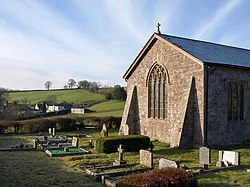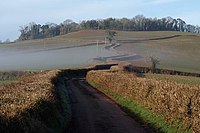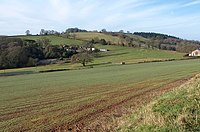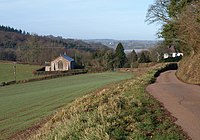Posbury
| Posbury | |
| Devon | |
|---|---|
 St Luke's Chapel, Posbury | |
| Location | |
| Grid reference: | SX813976 |
| Location: | 50°45’59"N, 3°41’4"W |
| Data | |
| Post town: | Crediton |
| Postcode: | EX17 |
| Local Government | |
Posbury is a hamlet in the midst of Devon, based on an ancient estate. It is found two miles south-west of Crediton and two miles north of Tedburn St Mary and, with the hamlet of Venny Tedburn a mile to the east.
An Iron Age hill fort, Posbury Hill Fort, is to be found close by the hamlet.[1] cut through by a modern road.. Just to the south of Postbury are the remains of an early Roman road, that ran from the newly discovered Roman fort, near Colebrooke, in an eastward direction towards Crediton.
Contents
History
There are signs around Postbridge of ancient eras, including the hill fort from the Iron Age, and a Roman road.
In the year 661, Cenwalh, King of the West Saxons fought a battle at Posentesburg, which W G Hoskins identifies with Posbury; the 'burg' (fort) may be the hill fort here.[2] The Chronicle does not state the result of the batlle.
The manor of Posbury is first recorded as held by the de Posbury family. On the failure of the male line, a daughter and sole heiress Eleanor de Posbury brought the manor to the family of her husband, a member of the Pollard family,[3] through whom the manor descended thereafter.
Posbury House
Posbury House was the historic centre of the settlement, long the property of the Tuckfield family, whose early home was here or at adjacent Venny Tedburn or at nearby Tedburn St Mary. John Tuckfield (1555-1630) of Tedburn moved the family seat to his newly purchased estate of Little Fulford, later renamed Shobrooke House, four miles north-east of Posbury.[4] In 1797 the Devon topographer Rev. John Swete visited Little Fulford and recorded in his journal that the "large woollen manufactory" of the Tuckfield family "has ever since subsisted in these parts".[5] Richard Hippisley (1774-1844), a distant cousin who later adopted the surname Tuckfield, inherited the Tuckfield estates and not only rebuilt Shobrooke House in the new Italianate style, but also in 1835 built St Luke's Chapel at Posbury.[4]
St Francis's Convent
Today, Posbury House is home to an Anglican Franciscan nunnery known as The Community of the Franciscan Servants of Jesus and Mary founded in Stepney in Middlesex in 1935 by Grace Emily Costin who took the name "Mother Teresa". The community moved in 1937 to the Isle of Wight and again in 1942, to escape the danger of enemy bombardment during the Second World War, to Posbury House, which they renamed The House of St Francis. During the War the community started to host retreats for candidates for ordination as priests in the Diocese of Exeter, which practice was only discontinued shortly before 2014. The house has its own chapel on site. By 2014 the community had dwindled in number, and the practice has ceased of the sisters working in the local community in areas connected with spiritual matters.[6]
St Luke's Chapel
St Luke's Chapel was built in 1835 by Richard Hippisley Tuckfield of Shobrooke House in order to supplement the capacity of the distant parish church, Holy Cross Church, Crediton, which had become overwhelmed by the number of its parishioners generated by the prosperous and expanding town of Crediton.
The Rev Samuel Rowe (a renowned antiquary) was rector of Crediton Church at the time and declared that his Sunday services were attended by between seven and eight hundred, which fulfilled the tight statutory conditions then imposed on the building of an additoinal church in the same parish. The new chapel, dedicated to St Luke, was built at Posbury in 1836 on a site owned by Mr Tuckfield, formerly called "Blackadown", alias "Pethams Postbury". R. H. Tuckfield established the required maiintenance fund, in the sum of £1,000 plus £5 for every £100 in building costs. The chapel was consecrated on 18 October 1836 by the Bishop of Exeter.
Posbury School
At about the same time as Richard Hippisley Tuckfield was building St Luke's Chapel, his wife Charlotte Mordaunt (1777-1848), daughter of Sir John Mordaunt, 7th Baronet, was building a small school in the lane opposite.[7] She had an "ardent zeal for the training of the deaf and dumb and of school masters for the poor" (as commented the Educational pioneer Sir Thomas Dyke Acland, 11th Baronet (1809-1898), both of whose wives were Charlotte's nieces).[7] Charlotte had developed an interest in teaching the deaf and dumb after a visit to her friend Grace Fursdon at Fursdon House, where she met her deaf and dumb protegée, who aroused her sympathy and interest. She travelled to Paris to study the teaching methods at the Institut National de Jeunes Sourds de Paris, the institution for the deaf and dumb run by the Venerable Abbé Sicard (d.1822). On her return home she sought out two similarly affected children and taught them herself. She was successful in her methods and was instrumental in establishing a school in Alphington Road, in Exeter, the precursor of the present Royal West of England School for the Deaf. She wrote a series of articles later published in a book entitled "Education for the People".[8] In 1838 Sir Thomas Acland established the Exeter Diocesan Education Committee, the first in Great Britain, which by 1840 had established St Luke's Teachers' Training College in Cathedral Close, Exeter. Thus there was little further need for Posbury School which closed and was for a while used as a Sunday School. In the 1920s, by which time it was serving only as a storage shed, it was demolished and its building stone served to make buttresses for the walls of St Luke's Chapel.[7]
Outside links
References
- ↑ Sellman, R.R.: 'Aspects of Devon History' (Devon Books, 1985) ISBN 0-86114-756-1. Chapter: "The Iron Age in Devon" (Map of Iron Age hill forts in Devon)
- ↑ Anglo-Saxon Chronicle Laud Chronicle (661)Her Cenwealh feaht on Eastron on Posentesbyrig
- ↑ Risdon, Tristram: 'A Survey of Devon' (1632), 1810 edition, p 101
- ↑ 4.0 4.1 [http://www.creditonparishchurch.org.uk/history/the-tuckfield-memorial/ Crediton Parish Church - The Tuckfield Memorial
- ↑ Journals of the Reverend John Swete (published in Travels in Georgian Devon: The Illustrated Journals of Reverend John Swete, 1789-1800, ed. Todd Gray & Margery Rowe, 1999)
- ↑ St Lukes, Posbury: The Community of the Franciscan Servants of Jesus & Mary
- ↑ 7.0 7.1 7.2 St Luke's: Posbury School
- ↑ St Luke's: Posbury


